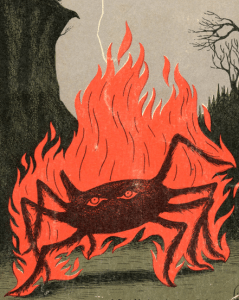 You may not know what Devil’s Night is unless you’re from Detroit, where arson-flavored rampages were traditional on the night before Halloween from the early 1970s until 1994, when a particularly determined mayor put his foot down. But long before the first car ever rolled off an assembly line, there were devilish nights aplenty back in the German-speaking forests and valleys of the 19th century, where Romanticism and its aftermath gave us countless uncanny tales. And of course the Devil is the ultimate Bad Boy: seductive, destructive, what’s not to like?
You may not know what Devil’s Night is unless you’re from Detroit, where arson-flavored rampages were traditional on the night before Halloween from the early 1970s until 1994, when a particularly determined mayor put his foot down. But long before the first car ever rolled off an assembly line, there were devilish nights aplenty back in the German-speaking forests and valleys of the 19th century, where Romanticism and its aftermath gave us countless uncanny tales. And of course the Devil is the ultimate Bad Boy: seductive, destructive, what’s not to like?
In 1842 a Swiss preacher named Albert Bitzius published my favorite friend-of-the-Devil story of all time, The Black Spider, under the pseudonym Jeremias Gotthelf. The story is definitely pedagogical in its intent: it aims to scare you into keeping the faith. Just as in all the most terrifying horror movies the monster is somehow always also the protagonist’s sinister double, the spider here is not only the Devil’s spawn, it has a human mother and can be held in check only by the God-fearing, those who are pure of heart.
I first read this story under unfortunate circumstances: all alone in my basement apartment in Baltimore one evening, with black linoleum floors and bars on the windows, completely surrounded by things that go bump in the night. I don’t know what I was thinking. Or, yes I do – I was thinking: Come on, how scary can it be? And I am here to tell you: It’s a great idea to read this story in a clean, well-lighted place, so that when it scares the bejeezus out of you there’ll be someone nearby to give you a hug. Trust me, you’ll want one.
Still, there’s more to Gotthelf than the fright. He’s a superb prose stylist, especially in the novel’s opening descriptive passages that are reminiscent of Stifter (as Isabella Kratynski of Magnificent Octopus also notes). Bolaño speaks highly of Gotthelf (Isabella quotes him too), and Thomas Mann writes in The Story of a Novel: The Genesis of Doctor Faustus that Gotthelf often “touches on the Homeric,” adding (with specific reference to The Black Spider): “There is scarcely a work in world literature that I admire more.” Kafka surely liked it too. Oh, and here’s a bit of vocabulary trivia for you: At one point Gotthelf refers to his unholy beast as an “Ungeziefer,” the same word that appears in the opening sentence of Kafka’s “The Metamorphosis,” as generations of translators have hand-wringingly observed. My translation of Kafka’s “bug story” comes out in January.
The Black Spider, on the other hand, just came out this week, and to my delight it’s already been reviewed in the New York Times Book Review, where Terrence Rafferty pronounced it “dire, bonefreezing” and “scary as hell.” So if you want to have your bones frozen in nice, safe company, why not come out for the book’s launch party on Devil’s Night, Oct. 30, 7:00 p.m. at McNally Jackson Books. Artist Martha Friedman, who knows a thing or two about spiders and visual discomfort, will be joining me to show some pictures and talk about images that scare us, and I’ll be reading from the story. The McNally Jackson announcement promises front-row seats to anyone who shows up in a spider costume. I hope I’m not too frightened to read. As luck would have it, I’m terrified of spiders.


I’m from Detroit–what a wholesome way of celebrating Devil’s Night! I have that Doubleday Anchor book of German Tales with the fantastic Gorey spider cover, but will look for your translation of the Gotthelf (and Kafka). Wish I could make the launch, but I’m in L.A. –Thomas Frick
Wow. Just finished your translation on my Kindle, and I now realize there aren’t nearly enough lights in my house tonight. Thank you for rendering the tale so beautifully in all its horror.